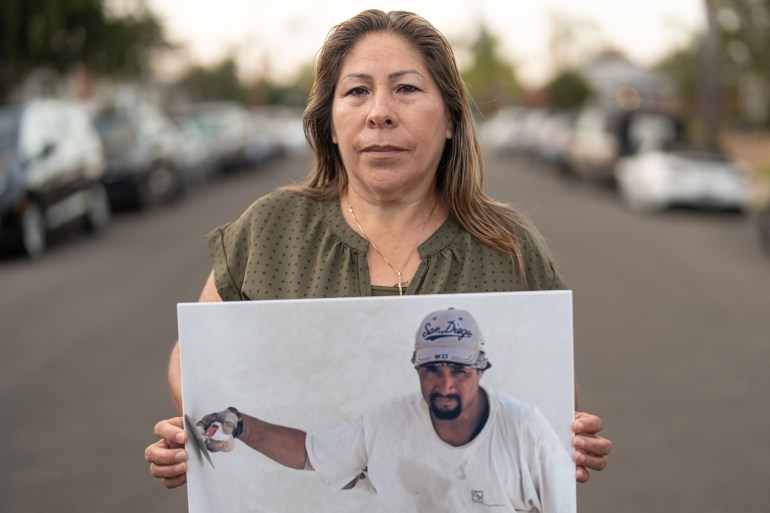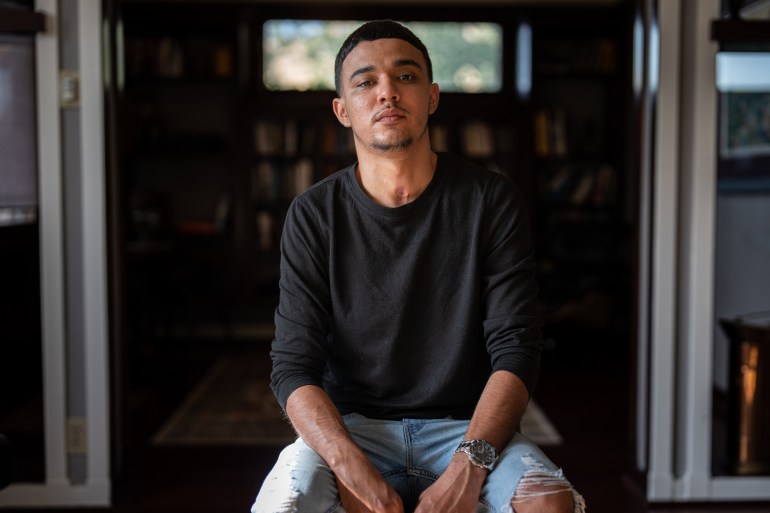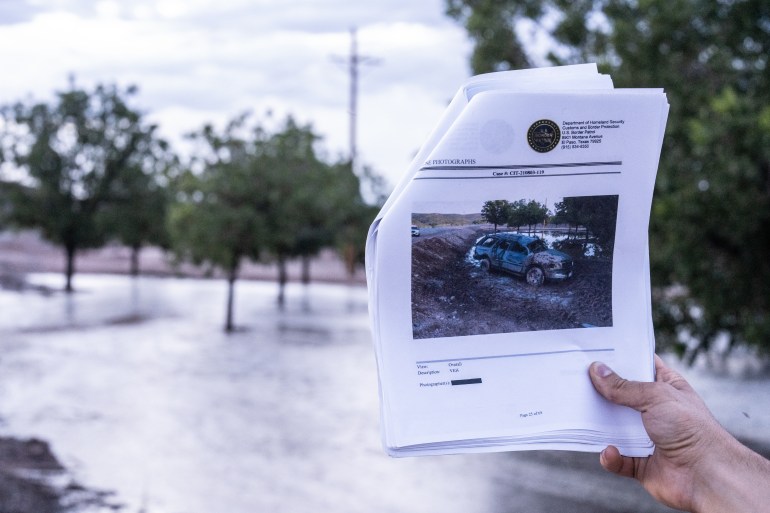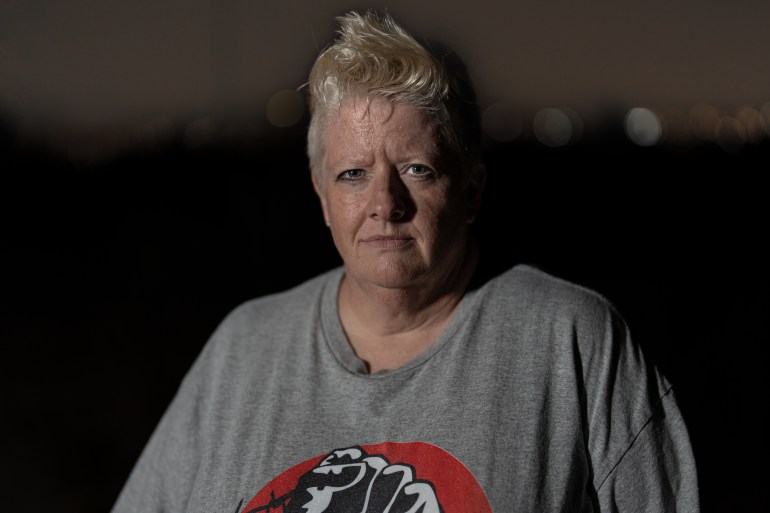The “Cover-up Teams” Working at the US Border Are “Hurting People”
An opaque team has responded when US Border Patrol pursuits of immigrant vehicles have resulted in mishaps.
 |
| Maria Puga holds up a photo of her late husband Anastasio Hernandez Rojas, who passed away in 2010 while under the care of the US Border Patrol. His passing exposed the existence of a covert division tasked with looking into incidents involving Border Patrol agents dying or getting hurt. [Josh Rushing/Al Jazeera] |
El Paso, Texas - Lesvin Gamez and eight other undocumented immigrants rode in the back of an SUV in the early morning darkness of August 3, 2021, along a remote road in southern New Mexico.
Although the 23-year-old was anxious, he felt better knowing that his mother was only 322 kilometers (200 miles) away in Albuquerque. He started cutting hair as a teenager in order to earn money to pay a smuggler, thus this has been his strategy ever since.
He boarded a bus for Mexico more than two months ago from his Honduran village on the Caribbean coast. He arrived at Ciudad Juarez, a city on the border with the United States that had experienced cartel violence, a week and a half later. Through the steel slats of the border fence dividing the two countries, he could see El Paso, Texas. In order to increase his income, he stayed there for two months, cutting hair, before deciding it was time to leave.
To dodge US border authorities on patrol, smugglers took him and more than a dozen other immigrants on foot for hours into the Chihuahuan Desert at night. Water and food were forbidden since they would just make them move more slowly. The smugglers told them to ascend to the top of the wall, leap to the ground roughly seven meters (23 feet) below, and then sprint as quickly as they could to the hills.
Gamez's years of playing football as a youngster has left him lean and athletic. He swiftly climbed the wall, but as he did so, he saw a woman who was pregnant fell from the top and not get up. She was hauled away by a man who ran to her rescue. Now in the US, Gamez swerved and fled into the pitch-black desert.
He traveled with nine strangers for the remainder of his journey after crossing the border. With each mile that passed, he believed the threat to be lessened.
 |
| Lesvin Gamez, 23, survived a crash involving US Border Patrol agents [Josh Rushing/Al Jazeera] |
I Felt the Border Patrol Strike Us Once More
This last trip from El Paso to Albuquerque was organized by the smugglers who assisted Gamez in entering the US. Erik Molix, a 25-year-old American citizen, was the driver. His enormous arms were covered in tattoos, and a smiling image of his mother hung from his forearm. He was tall, bearded, and tattooed. Gamez wasn't sure whether he could trust him because he didn't say anything during the drive. The other passengers also kept quiet. They eagerly anticipated the time when they would exit the SUV and make their way into the desert to elude detection by the US Border Patrol.
They passed a patrol car belonging to an agent when they were just a few kilometers from the checkpoint. Molix became anxious, accelerated his vehicle, pulled over, and yelled at his riders to exit the vehicle and flee. Gamez claimed a passenger in the front seat managed to escape, but the back doors were shut. Behind them, emergency lights began to flash. According to Gamez, the agent struck the SUV's rear just as Molix started to drive again.
He recalled that the coyote "grabbed the wheel like he was driving a Ferrari" as soon as they hit us in the back.
Gamez attempted to squeeze himself into the front seat in order to leap out, reasoning that the possibility of injury at this pace was preferable to get deported.
"I looked at the speedometer and noticed that we were moving at about 100 mph. Even the automobile was trembling. I felt the Border Patrol beat us again as soon as I stood up, and that is when I became unconscious.
The crash was put down to Molix by the Border Patrol. Later, the agency claimed that while evading pursuing agents, he "lost control and crashed" in a press release. No reference was made to the car being rammed.
Gamez was located by Al Jazeera's Fault Lines with the aid of a Honduran reporting partner. He has never before told his story before. He was never approached by the Border Patrol to ask for an account or to ask what had happened. His account conflicts with the Border Patrol's version of events and casts doubt on the participation of a shadowy squad tasked with gathering evidence to shield personnel from future legal action.
They are Cover-Up Groups
An SUV that seemed to be burdened down was spotted by an agent on patrol that morning, more than 100 kilometers (62 miles) north of the border, according to a US Border Patrol report. The SUV swerved past the Border Patrol checkpoint, sparking a pursuit. The chase, which lasted about a mile and a half, was joined by a second agent in a different car. It came to an end when the SUV overturned. According to an audio recording of the phone call, Border Patrol reported the collision to the local emergency operator and stated, "There was a vehicle that got clipped."
Gamez, Molix, and six other passengers were ejected from the car as it flipped over and came to rest upright in a soggy orchard. Gamez was unconscious for the subsequent six weeks. Soon after the collision, Molix and an Ecuadorian guy passed away.
Within 20 minutes of the rollover, agents contacted a covert group known as a Critical Incident Team, or CIT, according to agency records. A Border Patrol agent can be heard telling the officer, "Our Critical Incident Team is coming out," in body camera footage from the New Mexico State Police. They handle everything at the crime site. Not a crime scene, but key incident scene statements and diagrams, etc.
Few details concerning CITs' operations are known, and US Customs and Border Protection (CBP), the organization responsible for managing the Border Patrol, rarely makes them public. According to a recent memo released to the public, the agency's purpose is to "offer specialized and important support" to the Office of Professional Responsibility (OPR), which is the organization's internal affairs office and conducts agent misconduct investigations. They are permitted to take pictures of the incident and collect data that will be included in the final OPR reports.
But a training manual from within was exposed last year. According to the report, CITs "preserve and defend the integrity of the Border Patrol and its officers" in addition to "mitigating civil liability" for the agency.
An immigrant who died in Border Patrol custody in 2010 was the subject of an investigation by human rights attorney and activist Andrea Guerrero over the course of the previous year.
She claimed that having Border Patrol look into deaths involving its own employees is a glaring conflict of interest and that CITs might have been used to cover up wrongdoing. They are cover-up squads, she concluded, and that is all they are.
In addition to CITs, other law enforcement agencies, such as state and municipal police, the Department of Homeland Security, the FBI, and OPR, frequently respond to injuries or fatalities involving Border Patrol agents. However, the specifics and results of inquiries are rarely made public, and agents are rarely punished for misconduct. According to an internal analysis from 2021, Border Patrol personnel are only fired in less than 4% of misconduct claims.
A Deadly Collision
The 2010 murder of Anastasio Hernandez Rojas attracted worldwide attention and made CITs' involvement known. When he was a youth, Hernandez Rojas left Mexico for San Diego and resided there for more than 25 years without obtaining citizenship documents before being deported. The 42-year-old was stopped by Border Patrol as he attempted to re-enter the country illegally to be with his wife and five children.
His wrists and feet were shackled behind him as Border Patrol agents pummeled, kicked, and Tasered him. This was seen by onlookers from a pedestrian bridge. Later, witnesses said that agents had taken their phones and deleted the incident's images and recordings.
Hernandez Rojas sustained contusions, a broken back, five broken ribs, and a heart attack. At the hospital, he was pronounced brain dead; he passed away three days later. It was determined that he was murdered.
The US Department of Justice opted not to charge the participating agents despite allegations from Border Patrol that Hernandez Rojas was uncontrolled and belligerent.
The San Diego Police Department launched a homicide investigation following the incident as per customary protocol. The security camera footage that would clearly show what occurred to Hernandez Rojas was frequently requested by a detective. However, the tapes had been duplicated.
"The footage was handed out to numerous people. The Border Patrol Critical Incident Team's hands were the last to touch it, according to Guerrero. They had a responsibility to safeguard all the evidence, including the video, in their possession. Moreover, they didn't.
A witness came forward two years later with a cellphone video that was broadcast on the US television network PBS. It purported to depict Hernandez Rojas being tackled by an agent while being encircled, arrested, put to the ground, and bound. The witness claimed that she was hesitant to disclose the video because she was worried that Border Patrol would retaliate for what she had to say. She informed the media, "I had just seen a murder."
Create a new entity and give it a new name
Few details regarding the incident have been made public by Border Patrol, and no agent has ever faced punishment. However, the Inter-American Commission on Human Rights (IACHR) in Washington, DC, heard the Hernandez Rojas case on November 4. By issuing decisions and making policy recommendations, the IACHR, an intergovernmental organization made up of America-based nations, holds member states responsible to one another. This is the first time the commission has been presented with a case involving a victim of US law enforcement.
The family of Hernandez Rojas requests that the IACHR order the US Department of Justice to reopen the homicide inquiry, that CBP change its use-of-force policies, and that they publicly apologize.
The family still seeks accountability and reform after reaching a $1 million settlement with the federal government in 2017.
The widow of Hernandez Rojas, Maria Puga, stated that "any agent who violates a person's rights, who beats a person or murders deserves to be penalized." "I believe that is right in my opinion. No other family should have to go through what my family and I have. It must be put an end to.
A US government counsel argued at the IACHR that the lawsuit should be dismissed since a settlement had been made in federal court.
The commission will probably decide on the matter sometime in the next year.
Guerrero successfully persuaded the US Congress to look into CITs earlier this year.
After receiving criticism from Congressmen, CBP Commissioner Chris Magnus declared in May that CITs will be abolished. He also stated that OPR would take on CIT responsibilities and hire up to 350 more people. In an email, CBP informed Fault Lines that the units would be abolished on October 1 and that they would look at employing former CIT personnel at OPR.
Guerrero declared that "all the instances involving border officers need to be revisited and reinvestigated." Given that CITs have been in operation for 35 years, that number may be in the hundreds.
Former deputy assistant commissioner James Wong worked for CBP's internal affairs division. He spent a large portion of his career working for the federal government's internal affairs departments. He claimed that "CBP has the poorest accountability measures."
After CBP senior officials ignored Wong and James Tomsheck's warnings about corruption and cover-ups within Border Patrol, they turned become prominent critics of the agency's lack of accountability. He thinks that abolishing CITs is unlikely to have any impact. He predicted that they will reassemble the teams under an entirely different name.
 |
| The report photographed at the site of the crash shows the vehicle after it rolled on August 3, 2021 [Josh Rushing/Al Jazeera] |
The Accident Report
Shaw Drake, an attorney with the American Civil Liberties Union, got a 162-page investigative report of the August 3 crash from the Border Patrol's CIT after submitting records request to the New Mexico State Police. One of these reports has never been made public by Border Patrol.
Despite the emergency dispatch audio recording indicating that there was a "car that got clipped," the CIT investigation finds that there was no contact between the vehicles and provides no additional explanation.
So naturally, Drake posed the question, "Where did that originate from? " That had to originate someplace. That account was not made up by the dispatcher.
According to the CIT assessment, the incident most likely occurred because the car was overloaded with passengers.
There are pictures of Molix's SUV but none that are clearly of the agents' vehicles at the site. The CIT agent looking into the incident refers to one of the chase cars as a "marked sedan" in the chronology of events, while the images of the police vehicles allegedly involved are of SUVs, and they were taken six days later in an undisclosed area. In one image, an SUV belonging to the Border Patrol is seen being raised in what looks to be a mechanic's shop.
"There is no evidence in the report to support the assertion that those were the actual cars involved in the chase. The line of custody for those autos isn't documented, Drake claimed. "These are the only pictures we have—one in a garage, one in a parking lot."
The CIT report provides summaries of survivors' testimonies. However, none of them are longer than a phrase. The only information provided by the accounts is the survivor's seat and what they observed the driver does. Gamez claimed that before Fault Lines presented him with the crash report, he had never heard the Border Patrol's version of events.
Gamez remarked, "I don't know why they say we crashed. "There was nothing that we ran into. They were the ones that caused it when they hit the back of our automobile.
An email asking about the incident and the CIT's role received no response from CBP.
 |
| Angie Simms, the mother of Erik Molix, who died in the crash last August, says no one from Border Patrol has ever explained what happened to her son [Josh Rushing/Al Jazeera] |
A Series of Fatal Pursuits
With almost 20,000 Border Patrol agents, CBP is the largest law enforcement organization in the nation. Its authority stretches 161 kilometers (100 miles) from any boundary, which includes territory that is home to two-thirds of the US population.
More migrants are being detained by the Border Patrol at the US border than they were sixty years ago. And as a result, between 2019 and 2021, the number of people killed in car pursuits involving Border Patrol agents climbed elevenfold. With at least 19 deaths arising from border agent chases, this year was the bloodiest yet.
According to the Southern Border Communities Coalition, a group that pushes for more control over border officers, at least 145 people have reportedly died in high-speed chases and use-of-force events involving Border Patrol since 2010. None of those fatalities had any indication that agents had been disciplined, according to Fault Lines.
The former CBP official, Wong, claimed that the organization "never recognized the fact—or they would not accept the fact—that they were a law enforcement agency and had to abide by the law."
Erik Molix's mother, Angie Simms, still has no answers more than a year after the New Mexico disaster. No one from Border Patrol, according to the woman, ever explained what happened to her kid that early in the morning. She organized a memorial service for him, and attendees released white balloons.
"You know, no child is perfect; he had his faults. I do, however, know him and how he is. He isn't a bad man. She said that her son "never was."
 |
| Jenn Budd, a former Border Patrol agent and now a critic of the agency, says she was trained to make fleeing cars crash [Josh Rushing/Al Jazeera] |
They are doing People Harm
The night of the crash, Molix was due to pick up his laundry from his mother's residence in El Paso. After he vanished, she and her sister conducted a five-day hunt for him. Every hospital they contacted in the vicinity said Molix wasn't present. One of those hospitals employs Simms' sister, who works as a nurse. She had heard of a vehicle accident when several people were helicoptered in. When she went to check on the ICU at the hospital where she works, she discovered Molix unconscious.
Simms remarked, fighting back tears, "He was there by himself for five days, lying there, other people making decisions for him."
Molix's lungs failed, and his spine was broken. He was flung off the truck and sustained a catastrophic brain injury. Agents were still observing him in the hospital lobby. But none of them would tell Simms why her son was being kept alive by a machine. Nearly two weeks after the tragedy, Molix passed away in the hospital.
Simms claimed that even though Molix had his driver's license with her address on it and was in possession of it, neither the agents nor the hospital ever called her to let her know that he had been in an accident.
They lack transparency. They're concealing information, she claimed. "Border Patrol is clearly doing something, and they continue doing it while knowing that they are harming and killing people."
The high-speed pursuit regulations of many US police agencies are becoming more stringent, prohibiting officers from participating except under very specific conditions. CBP said earlier this year that it would adjust its pursuit policy to prioritize safety in response to demands from lawmakers. New rules, however, have not yet been made public.
An agent with the Border Patrol located in San Diego was Jenn Budd. She is now speaking out against the agency. She claims that she was taught to cause speeding cars to crash. "In the academy, they teach you the professional manner that, number one, it's not worth chasing a car at high speeds through a school zone or anything like that if you suspect that they are undocumented migrants," she said. However, they train you to chase them until they crash once you're in the field.
 |
| Gamez woke up from a coma six weeks after surviving the crash [Josh Rushing/Al Jazeera] |
Miracle has Woken Up
Six weeks after the collision, in September 2021, Gamez emerged from a coma at a Salt Lake City, Utah, hospital. His speech was harsh from being intubated, and he was unable to move his legs. He was fortunate to be alive, the nurses assured him. He was unaware of the severity of the crash. His head and spine were broken, and a chunk of his scalp was missing. The doctors came over and said, "Hey, he's awake, "Miracle" is awake," but they didn't call me by my name. Just a "Miracle," they referred to me. They simply called me "Miracle," not Lesvin.
He answered, "It's their job. "They are paid to do that, but they ought to find a way to do it without endangering or taking human life. If that's the case, they should just wait for us with firearms at the border and shoot us before we cross. Since that is essentially what they are doing.
SOURCE: AL JAZEERA
READ: Harry Dunn's Killer, a US Driver, Won't Attend the Sentencing
Post a Comment